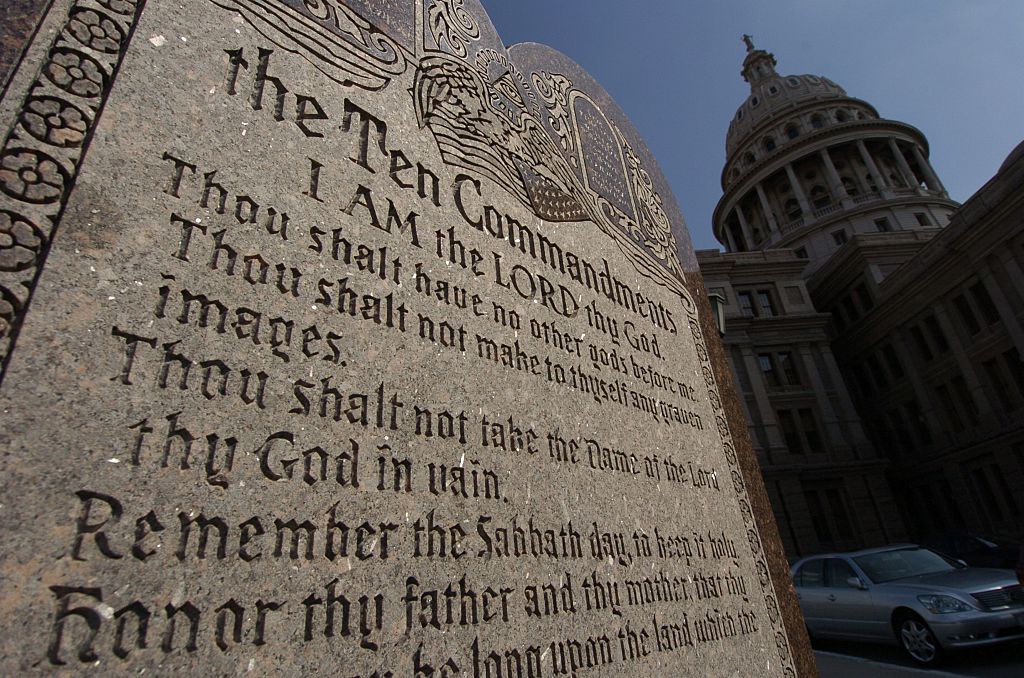
After decades of jurisprudence, more rulings on the Decalogue stir controversy.
A Louisiana law requiring the display of the Ten Commandments in public schools has been struck down by the Fifth Circuit Court of Appeals as unconstitutional. Texas Gov. Greg Abbott just signed a similar bill, which will likely struggle under the Fifth Circuit decision, while plaintiffs in Arkansas have filed suit challenging a nearly identical statute in the Eighth Circuit. Should that appeal rule the Arkansas law is constitutional, the split between the circuits may influence the US Supreme Court to take up the matter.
A Controversial History
The Supreme Court addressed almost precisely this issue in 1980 in Stone v. Graham, when a Kentucky statute that required the posting of the Ten Commandments on the wall of every public school classroom in the state was struck down for violating the establishment clause of the First Amendment because the purpose of the display was overtly religious. Kentucky was rebuked by the SCOTUS again in 2005 for posting the Ten Commandments on courthouse walls, in McCreary County v. ACLU of Kentucky.
Yet, a Texas monument memorializing the Ten Commandments on public property was upheld by the same 2005 Court in Van Orden v. Perry. The jurisprudence on the establishment clause includes a three-pronged test enunciated by the US Supreme Court in 1971 in Lemon v. Kurtzman. To pass constitutional muster, a statute must have a secular purpose, its primary effect must not be to advance or inhibit religion, and it cannot create an excessive “government entanglement” with religion.
This test generally decides whether a particular display will stand or fall. In 2003, the Eleventh Circuit struck down an Alabama monument to the Ten Commandments in Glassroth v. Moore. It was prominently located in a state judicial building at the direction of the Alabama Supreme Court chief justice, who refused to permit secular monuments beside the Ten Commandments and stated openly that its purpose was to invoke “the favor and guidance of Almighty God.”
A Secular Monument?
This contrasted with the 2005 Texas case Van Orden v. Perry, because the Texas memorial was one of several dispersed on the capitol grounds and was not placed in a prominent position. The Supreme Court noted the dual purpose of the establishment clause in creating a wall between church and state while recognizing the strong role of faith in American history. The majority also emphasized the secular nature and long tradition of the Ten Commandments being displayed.
The Ten Commandments have historical importance, much like the Code of Hammurabi and the teachings of Confucius. Often favored by Christians, the list of godly decrees announced by Moses became the foundation of Judaism and is contained in slightly varied form in the Islamic Koran. The purpose of the First Amendment was not to erase religion from government but to ensure governments did not favor one faith tradition above another.
From this perspective, the traditions of the Abrahamic religions should not eclipse polytheism, deism, other faith traditions, or even atheism. Yet if atheism is a religion – as the Seventh Circuit Court ruled in 2005 in Kaufman v. McCaughtry – then it, too, should be separated from government favoritism. Public schools routinely instruct children that theories of evolution and the Big Bang are truths, implicitly if not overtly pushing aside other faith traditions that believe in a god or gods.
Ten Commandments in Classrooms
North Dakota and South Dakota have enacted laws that permit, rather than require, teachers to display the Ten Commandments in classrooms. Those laws may withstand a constitutional challenge more effectively if the legislative history reflects a secular educational intent rather than an effort to instill a particular religious view.
Tension between Americans of faith has persisted since the nation’s founding and the constitutional effort to separate church and state in the establishment clause, which was enacted together with the free exercise clause in the First Amendment, stating “Congress shall make no law respecting an establishment of religion, or prohibiting the free exercise thereof.” The founders’ goal was to protect religious liberty while preventing religious divisiveness.
The United States has steadily shifted to a more secularized society, prompting efforts by the faithful to restore faith traditions in government at the same time that a growing atheistic segment of the population desires to keep them out. The new Texas and Arkansas statutes mandating the posting of the Ten Commandments in public schools will undoubtedly be challenged in court and likely be struck down, similar to Louisiana’s. Maintaining balance between views of the afterlife will continue to create challenges for Americans seeking to live amicably in the present one.
Dig Deeper into the Themes Discussed in this Article!
Liberty Vault: The Bill of Rights
Liberty Nation does not endorse candidates, campaigns, or legislation, and this presentation is no endorsement.

















